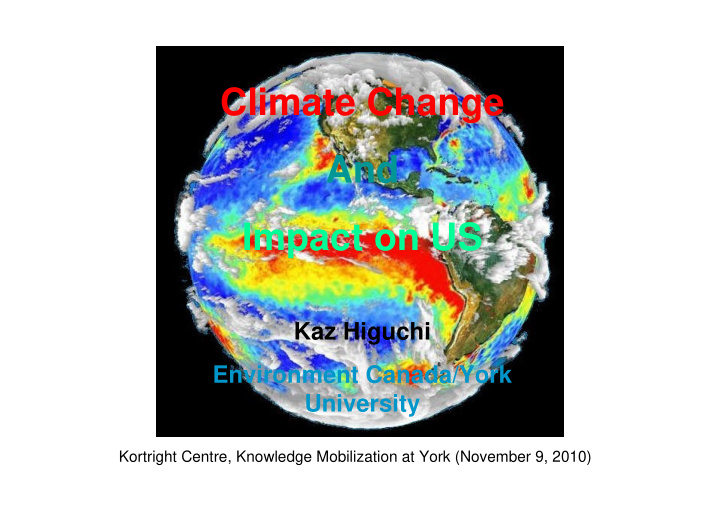



Climate Change And Impact on US Kaz Higuchi Environment Canada/York University Kortright Centre, Knowledge Mobilization at York (November 9, 2010)
Where is the Science? Consensus !? Alarmist <-------------------------------------> Skeptic
Great Natural Disasters Worldwide 1950 – 2008 Number of Events Earthquake, tsunami, volcanic eruption Earthquake, tsunami, volcanic eruption Storm Storm Flood Flood Temperature extremes (e.g. heat wave, wildfire) Temperature extremes (e.g. heat wave, wildfire) Weather-Related Disasters On the Rise Year Joan Klaassen (Env Canada)
Natural Disasters in Canada Frequency of Natural Disasters in Canada (1900-2005) 160 Wildfires Highest % of Natural Disasters Avalanches in Canada are Flooding Events Cold Waves/Heat Waves 140 Droughts Earthquakes/Landslides 120 Number of Natural Disasters Floods Floods Freezing Rain 100 Hail/Thunderstorms Hurricane/Typhoon Storms 80 Tornados 6 years Tsunamis/Storm Surges 60 data! 40 20 0 1900-09 1910-19 1920-29 1930-39 1940-49 1950-59 1960-69 1970-79 1980-89 1990-99 2000-05 10 Year Period
Vulnerability to Flooding Intense Thunderstorms Edmonton Storm – July 11, 2004 • Over 100 mm rain, up to golf ball size hail Photo credit: Rachel Kulasas in just over 90 minutes • Evacuation of West Edmonton Mall • Storm sewer overflow, basements flooded • $180 million in damages Source: Joan Klaassen (Environment Canada)
Vulnerability to Flooding Rainfall from Large Scale Storm Systems Saguenay, QB – July 1996 • 290 mm of rain in less than 36 hours • 10 deaths • Canadian Red Cross assisted in evacuations of over 15,000 people from homes • Roads, bridges washed out • Estimated costs at $1.7 billion NS, south NB, west NL – March 31, 2003 (early April) Truro, NS • Heavy rain + thaw: ~80-120 mm rain • Evacuations in Truro, NS • State of emergency Oxford, NS • Roads, bridges washed out • Estimated $15.6 million losses NS public infrastructure alone (2003) Source: Joan Klaassen (Environment Canada)
Environment Canada Ontario HIRA Survey Climate Change and Municipal Risk Climate Change is Important to Municipal Emergency Management Planners Climate Change in the HIRA No 5% Unsure Municipalities need: 13% • Climate Trends (current & projected) YES 45% • Impacts, Scenarios (www.cccsn.ca) YES • Impact Thresholds In Future 37% Source: Joan Klaassen (Env. Canada)
Future Evolution of Climate …… .. ???
Climate Models
• Climate models are constructed from systems of differential equations based on the basic laws of physics, fluid motion and chemistry. • Many small-scale interactive processes are parameterised based on empirically- derived relationships (based on observation). There is no unifying theory of climate
Zero-Dimensional Energy Balance Model Globally Averaged W.F. Ruddiman
Budyko-Sellers One-Dimensional Energy Balance Model These types of models take into account the surface latitudinal dependence of insolation (no dynamics) From Hartmann (1994)
Two-Dimensional Multilayer Energy Balance Climate Model Relationship between LSE and T/ y Horizontal Temperature Gradient : T/ y Eq LSE can be approximated as NP diffusive transport in 2-D by: Annual : T=~35 Wnter : T=~50 Summer : T=~25 LSE is a function of T/ y Seasonal Variation of T/ y Seasonal Variation of LSE
Three-Dimensional Model of Atmosphere/Climate
Can You “ Believe ” In Climate Models?
There are “ real holes in climate science ” Reference: Schiermeier, Q., 2010: The real holes in climate science. Nature, 463, 284-287.
Precipitation • Model results in IPCC 4 th assessment show very diverging spatial pictures of snow and rainfall (particularly in winter) – no robust prediction • Models tend to underestimate how much precipitation has changed already • Poor simulation of convective processes • Poor understanding of the role of aerosols
Aerosols • Poor understanding of the role particles such as sulphates, black carbon, sea salt, dust play in temperature and rainfall • Some aerosols cool and others warm • Need to untangle the interplay between pollution, clouds, precipitation and temperature
Regional Climate Prediction • Most crucial information for human adaptation to climate change is the least reliable. • Spatial resolution of 1-3 deg. latitude and longitude (very coarse) • Increasing resolution can lead to problems • Limitations of regional simulations need to be clearly understood
But climate models are NOT useless • Help us increase our understanding of various processes that we know about (and discover those that we still don ’ t know about) that influence climate change and variability • Provide guiding information in our attempt to develop optimal climate change adaptation strategies
Thank you
Recommend
More recommend